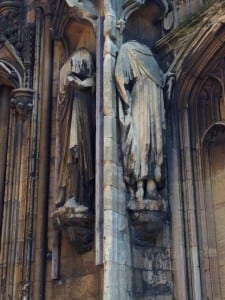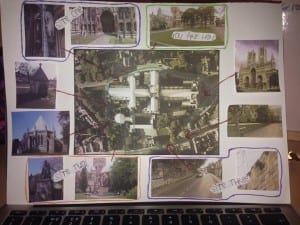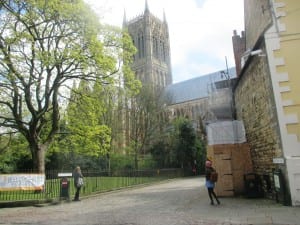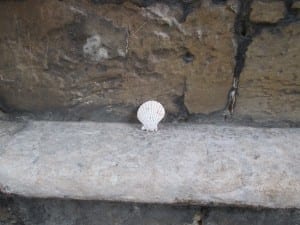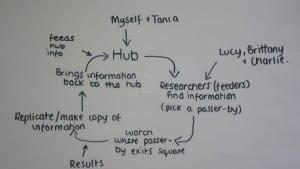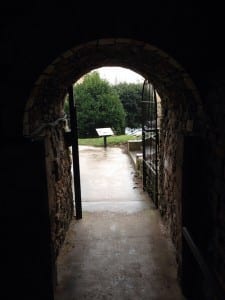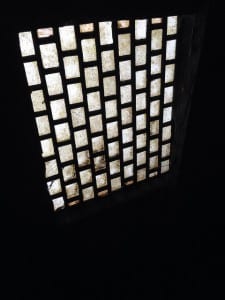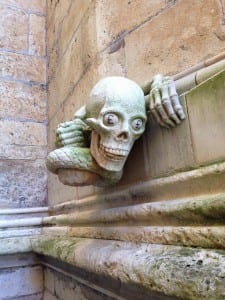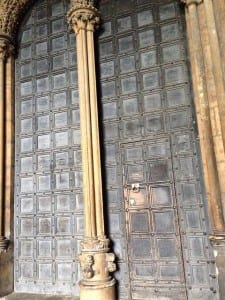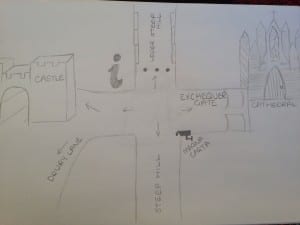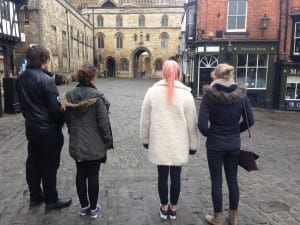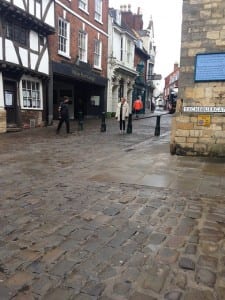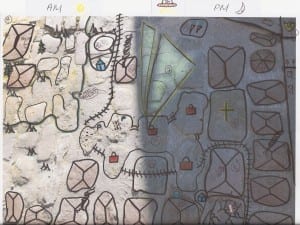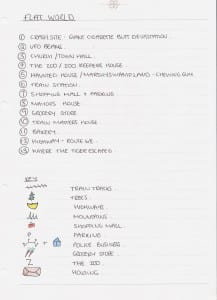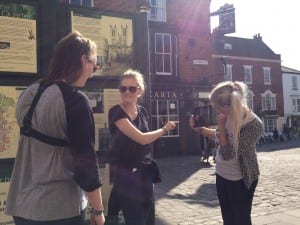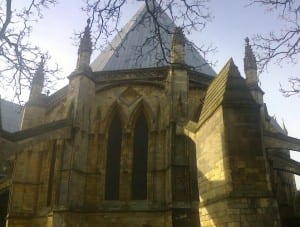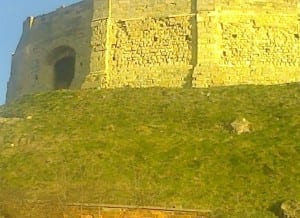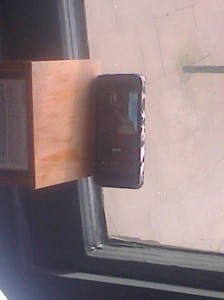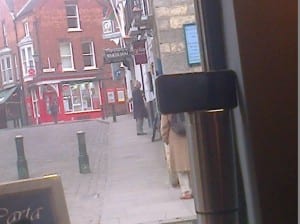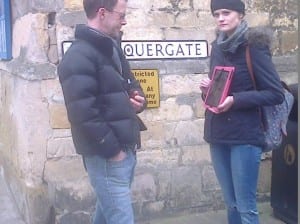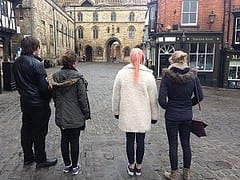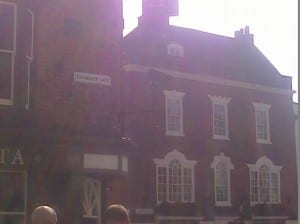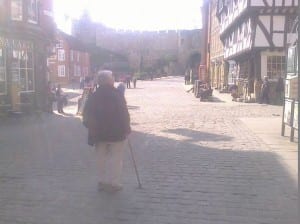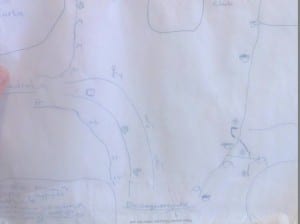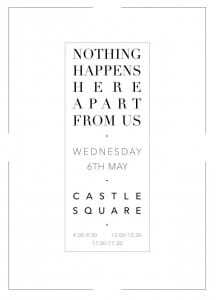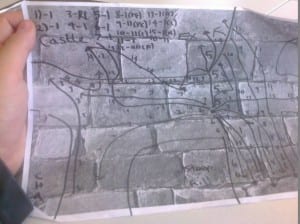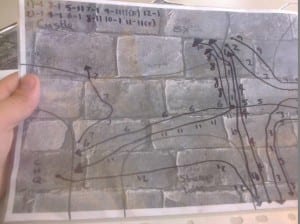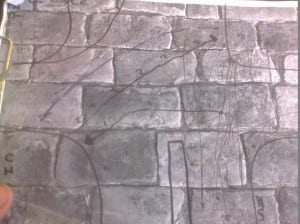Framing Statement
“Site-specific performance can be especially powerful as a vehicle for remembering and forming a community[…] its location can work as a potent mnemonic trigger, helping to evoke specific past times related to the place and time of performance and facilitating a negotiation between the meaning of those times”. (Harvie, 2005, cited in Pearson, 2010, 9)
Our Site Specific Performance took place on the 6th May 2015, around the Bailgate and cathedral area. We invited people on our course as well as non drama students. Our performance looked at the 1185 earthquake which destroyed a lot of Lincoln, including the cathedral. We hoped to inform people about what happened as it is not a very well known event. Our performance was aptly named Disturbance to reflect both the disturbance of what the earthquake would have created, as well as the everyday disturbances that people experience e.g. screeching children and bumping into people.
One of the first theories we looked at during our Site Specific module, was the ‘drifting’ theory. Starting in castle square we went on an adventure around the top of Lincoln, moving around a place without any set destinations or pathways to follow. This technique led us to areas of Lincoln which tourists would like, such as the high water tower and the Roman well. It also led to other places they would not like, such as the public toilets which no doubt have had their fair share of visitors.
During one of our seminars, we were set the task of listening to Adrian Howells’ podcast, created for The Guardian (2011). ‘Everyday Moments’ is a podcast series created by theatre producers, Fuel and Roundhouse Radio. Each of the podcasts is created by different artists.
The nine minute audio track featured an assortment of noises and sounds. The instructions were to listen to it in bed, in the early morning with a hot drink. I did not follow these instructions and this may be why I experienced different reactions to the podcast comparted to other people. Due to the variety of experiences I had, I knew I wanted to create my final piece using audio as the main focus. As even though reactions to the piece may not be what the creator (or I) set out to accomplish, the listener still experiences something stimulating from it.
The other main influence for our piece was Janet Cardiff. Her name was brought up by one of the members of our group. Lizzie liked Cardiff’s Memory Walk, whereas I had more of a connection to Cardiff and George Bures Miller’s FOREST (for a thousand years) (Cardiff Miller, 2012). I enjoyed the back to basics, simple performance which was an audio piece in the forest. The tranquil surroundings were highlighted by the sound installation. Gregory Volk says,
“A remarkable thing about Janet Cardiff and George Bures Miller’s utterly captivating sound installation is how it blurs distinctions between site and art. You enter a clearing in the forest, sit down on a wooden stump, and simply listen. Cardiff and Bures Miller’s work incorporates the actual forest into an audio composition emitted from more than thirty speakers. Sometimes there is a near synchronicity of natural and mediated sounds, and it’s tough to discern what is live and what is recorded.” (Volk, 2012, cited in Cardiff and Miller, 2012).
I completely agree with Volk and see what Cardiff and Miller were aiming to achieve; their piece could open up the mind, allowing the audience to think about the space for themselves but with some stimulation in the background to help them accomplish this.
Analysis of Process
First Ideas
Our performance went through a few changes before we had our final piece in place. From the start we all liked the idea of an audio walk but we also wanted to add a twist onto it. One of our ideas was to have our audience participate in an audio game (almost like a scavenger hunt). The idea of incorporating the cathedral into our performance intrigued us so, bearing this in mind, we looked around the building for some ideas to use. That was when we came across the war memorial part of the cathedral, the side room dedicated to those who perished in WWI, WWII and the most recent wars. It was quite daunting, walking around that room as there were historical artefacts such as old battered Union flags from the different time periods and old records which listed the dead. It struck a chord as in that moment the wars became all too real and also highlighted just how important Lincolnshire was during the wars and even to this day, how many RAF bases there are in Lincolnshire. We knew at that moment we wanted to use this as some sort of basis.
We were going to start our audience off with a pre recorded tour which would have instructions on it to follow. We had the idea of having a choice of three walks so that our audience members could experience different things and could discuss their findings with each other. One of the walks would have incorporated the war memorial in the cathedral. The audio would include bomb sound effects along with the audience being told to duck or find somewhere to hide. Their path would have started at the castle, thus including the historical elements of wars and battles and would have led to the cathedral. We would also have told the audience members who were taking the tour, facts about Lincoln during the war.
 Inside the cathedral (Cleasby, 2015)
Inside the cathedral (Cleasby, 2015)
The only problems we thought we had with this idea would be getting the permission to go inside the cathedral and use it as part of our tour as well as the issue of entrance fees. However, it took us a while to realise that our first idea was flawed from the start as the RAF is connected to Lincolnshire, not Lincoln itself, making it not specific enough for our site and therefore our performance. We were also over complicating our performance by wanting to include two different audio pieces; one was the ‘war tour’, where the listener would be surrounded by bombs detonating, air raid sirens and bomber planes flying over and the other was a new idea of the 1185 earthquake, which we had little to no information on, as we had hardly researched it.
The next contextual idea was the theme of ‘Heaven and Hell’, using Exchequer Gate in front of the cathedral to represent ‘judgement’, leading our audience around the cathedral in two separate directions, which would be determined by the ‘judgement’ cast on them. This idea was scrapped due to the unperceived negative religious connotations which could be connected to the performance. We also did not go along with this idea because we felt as if we had just picked something at random and run too fast with it; there was no rationale behind this idea. We soon found out that this idea was not the direction we wanted to go with our performance.
Our Final Performance Idea
Upon showing the RAF idea to our markers, we also showed them a second idea which was the 1185 earthquake in Lincoln. We were told that this was an interesting path to go down and that we should pursue this concept further. This led us into researching more about the earthquake, whereabouts in Lincoln it had hit and what was the damage it caused.
We found out that the majority of the cathedral was part of a rebuild which was caused by a few earthquakes and a fire which had destroyed most of the building. The cathedral as it stands now is a lot bigger than its predecessor. With each different destruction, new parts of the cathedral were slowly built, renovated and restored.
The Audio
The audio was the main element and force of our Site Specific performance, (our route was important also) but I felt that if our audio was not up to scratch, the performance could fall flat. I took a step back from creating the actual track as I have limited technical knowledge and I was aware that I did not know how to use the software. However, I always gave my feedback into the track as it went through the processes of change.
With each new edit, I believe our audio improved greatly. The sounds became crisper, the rumbles became more understated but very powerful and the inclusion of definition of an earthquake added a subtle element; there is never any specific mention of an earthquake, but it is casually described during the opening speech. Maybe an audience member would understand what we meant from it, maybe they would not. It is down to personal perspectives and that is why we wanted to include a verbal part at the beginning, encouraging the audience to think.
We also decided to include the ‘call for information’ at the end of our track. This was information our group found when researching the earthquake in the archives of the Lincoln Library. There had been a call put out to the neighbouring cities asking for any information surrounding the 1185 earthquake. By adding the definition and the ‘call for information’, I think that the audio track was drawn together in a conclusion. However, we did leave the audio piece slightly open ended, allowing for questions for our audience to think about. ‘Did they know of anything, did they have any information that would help with more research and knowledge into this specific event?’
In my opinion, I think we left creating the audio track to quite late in the day. By doing this, it sometimes became hectic to fix any bugs we had in the track. If we had created it sooner, we could have done a few more edits and versions on the piece, during our different dress runs, allowing for it to flourish a bit more and making for a better listen. However, I understand how difficult it can be in creating an audio track, therefore, I think the track we created in the time we had is a very strong piece of performance.
One of our versions of the audio walk (George Murphy, 2015a) – https://www.youtube.com/watch?v=GXUbt03RO0Q
Another version of the audio walk (George Murphy, 2015b) – https://www.youtube.com/watch?v=u17MDojWzYA
The final version of our audio walk (George Murphy, 2015c) – https://www.youtube.com/watch?v=IYCMGL2QHTw
The Route
The next idea was to construct the route which our audience members would take when participating in our Site Specific performance. We knew we needed a route which held importance to the whole performance. I was set the task of finding the route and I have to admit that I found this difficult. I was in charge of this side of our performance going back to our idea of the RAF, and as mentioned previously, there are no connections to the RAF around the Bailgate area. So when we changed our idea, I thought it would become slightly easier, but I was wrong.
Researching a route with a specific need in mind was difficult when I did not have that much information to go on. Other members of the group were looking into the history of the earthquake and relaying the information back to myself. Even this did not help me all that much to begin with, as I had no idea where to start our performance from but I know we wanted it to end facing the cathedral.
 Looking at the cathedral from Exchequer Gate (Cleasby, 2015)
Looking at the cathedral from Exchequer Gate (Cleasby, 2015)
However, my problems were fixed when during one of our meetings at the top of the hill, I was told an ideal route had accidentally been found; from Newport arch to Exchequer Gate. This route would serve a few purposes: firstly, our performance would start and finish walking through the arches, so that the end would mirror the beginning; secondly, the Newport arch is one of the last remaining Roman arches and the only one used for everyday transportation; lastly, the arches were at a distance from each other which would work with our audio track, as it allowed for the build up we needed to create the desired effects.
Exchequer Gate (Cleasby, 2015)
After walking this route and listening to the audio during dress runs, we found that we were through Exchequer Gate and looking at the cathedral too soon. The audience would have been waiting for the concluding events for too long. Therefore we decided to slightly change our route. We kept it the same but told our audience to ‘loop’ around Castle Square; this gave more time for our audio to reach its peak when our audience were at the cathedral, but without making them wait too long for it.
We also decided to introduce the walk at the start. Lizzie introduced the audio walk to our audience, explaining what they were about to participate in but without giving too much away. She also provided the audience with some facts and information about the history of Lincoln, and the two arches.
Kia was placed at the end of our route; she was there for the audience members to relay their thoughts and feelings about what they had just participated in and to answer any questions they had.
Performance Evaluation
The day of our performance was a very wet and windy day and I had some reservations about whether the people, who said they were going to turn up, would actually come and I was right to have had this doubt. Including our two markers, Disturbance had five participants. This was considerably lower than the group had hoped for. The turnout became disconcerting during our performance as it felt as if all the effort put into our performance would go to waste.
Out of the three participants (not including our markers) we received feedback from just one. She liked our piece and enjoyed the total collapse of the cathedral when sitting looking at it and taking it all in. The problem with not having any feedback was that we were meant to send a questionnaire or evaluation for the audience to complete and send back to us. This was never completed and therefore was never sent to anyone. This was one of the problems we ran into; we never found out how the participants felt about the experience of Disturbance.
As to whether the final performance triggered any new ideas, I have to say no. I do feel though, that myself, Jess and George could have had more of an involvement during the actual performance but as to what that could be, I have no idea. I know we needed to be spread about our route just in case there were any technical issues but I feel as though we could have done a bit more.
I think the slow build of our soundscape worked very well. The casual rumble which was underneath the ‘real life’ noises helped bring a feeling of suspense, without giving too much away. Then as the audience was sitting or standing (whatever they felt inclined to do), looking at the cathedral, the rumbles would increase into this loud and shocking collapse of the cathedral. On the other hand, I believe that there were a few technical glitches that were not meant to be in among the other purposeful glitches. I think if these were noticed then this would have taken away from the experience, bringing the participant out of the mind-set we were trying get them into. By sorting this out, I think that the audience could have achieved a deeper level of connection with our audio walk. I also think that we could have increased the length of the audio track, therefore increasing the length of the walk. This could have amplified the depth of experience for the participant as there would have been more to listen to. I also think we could have had a wider variety of sounds; the natural high street effect worked well, but sometimes it became too ‘same-y’.
If I were to perform this again, I would make the above improvements, but I would also like to do the performance on a sunny day, again giving the audience members a different experience. This would be a hard change to make as the weather is very unpredictable.
I would also include a feedback questionnaire or form; the audience would either have been given this straight after the performance (even though that could disturb the thoughts of the participants if they filled information in after experiencing the audio walk), or via email at a later date. I would make sure I would have a way to obtain information from the audience which could include: ways to improve, things they liked and did not like as well as their thoughts about the audio walk.
I can say that I have learnt a lot during the Site Specific module; I have learnt that ‘performance’ is subjective and there is more to ‘performance’ than just acting. However, saying this, I can truly say that I do prefer the ‘straight’ acting which leans more towards Shakespeare than Yoko Ono. Even though the module has been an eye opener, I know it is not for me, but I accept this as everyone puts their own stamp on drama, theatre and performance. The whole objective is to make you think and this module did just that.
“Site-specific performance – acts of theatre and performative events at landscape locations, in village streets, in urban situations. In houses, chapels, barns, disused factories, railway stations; on hillsides, in forest clearings, underwater. At the scale of civil engineering; as intimate as a guided walk.” (Palgrave Macmillan, 2010)
Bibliography
Cardiff Miller (2012) FOREST (for a thousand years). [online video] Available from https://www.youtube.com/watch?v=hGqPwaZVPBo [Accessed 22 May 2015].
Cardiff, J. and Miller, G. B. (2012) FOREST (for a thousand years…). [online]. Available from http://www.cardiffmiller.com/artworks/inst/forest.html [Accessed 22 May 2015]
Cleasby, J. (2015) Site. [Flickr] 4 March. Available from https://www.flickr.com/photos/131251871@N04/ [Accessed 18 May 2015].
George Murphy (2015a) Audio walk V1. [online video] Available from https://www.youtube.com/watch?v=GXUbt03RO0Q [Accessed 15 2015].
George Murphy (2015b) Audio walk V2. [online video] Available from https://www.youtube.com/watch?v=u17MDojWzYA [Accessed 15 2015].
George Murphy (2015c) Disturbance Audio Walk. [online video] Available from https://www.youtube.com/watch?v=IYCMGL2QHTw [Accessed 15 2015].
Palgrave Macmillan (2010) Site Specific Performance. [online] Available from: http://www.palgrave.com/page/detail/sitespecific-performance-mike-pearson/?K=9780230576704 [Accessed 22 May 2015]
Pearson, M (2010). Site specific performance. Basingstoke: Palgrave Macmillan.
The Guardian (2011) Everyday moments Adrian Howells. [podcast] 21 November. Available from http://www.theguardian.com/culture/audio/2011/nov/21/everyday-moments-podcast-adrian-howells [Accessed 17 February 2015].


